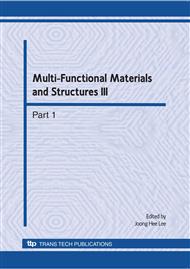p.519
p.523
p.527
p.531
p.535
p.539
p.543
p.547
p.551
Effects of Graphene on a Resin Transfer Molding Process Using Bisphenol A Based Epoxy Resin
Abstract:
Resin transfer molding is a popular process to fabricate polymer composites reinforced with a large amount of glass or carbon fibers. In general, fiber reinforcements are put in a mold, and a liquid resin such as epoxy resin is injected into the mold after preheating. For successful production of polymer composites via a resin transfer molding process, the filling and curing stages of the liquid resin as well as the mold design should be optimized. Recently, polymer composites reinforced with nanoparticles are attracting attention of researchers in academia and industries because efficient reinforcement can be achieved by small loading of nanoparticles such as carbon nanotubes and exfoliated clays. In this work, as an effort to develop light weight automotive parts, graphenes were investigated as a nano size reinforcement of epoxy resin for resin transfer molding. Graphenes were prepared from graphites by microwave irradiation. Addition of graphenes to bisphenol A based epoxy resins such as YD-128 from Kukdo Chemical results in an increase in viscosity and shear thinning behavior, affecting the filling process. The curing of epoxy resins is also affected by graphenes. In order to develop a model for simulation of the filling and curing of epoxy resins containing different amounts of graphenes in the resin transfer molding, FLUENT and MATLAB have been used in this study, which are a finite element based computational fluid dynamics analysis tool and a general purpose numerical analysis tool, respectively. The effects of graphenes on the mold filling pattern and curing profile are discussed for the resin transfer molding of bisphenol A based epoxy resins.
Info:
Periodical:
Pages:
535-538
Citation:
Online since:
August 2010
Price:
Сopyright:
© 2010 Trans Tech Publications Ltd. All Rights Reserved
Share:
Citation:



